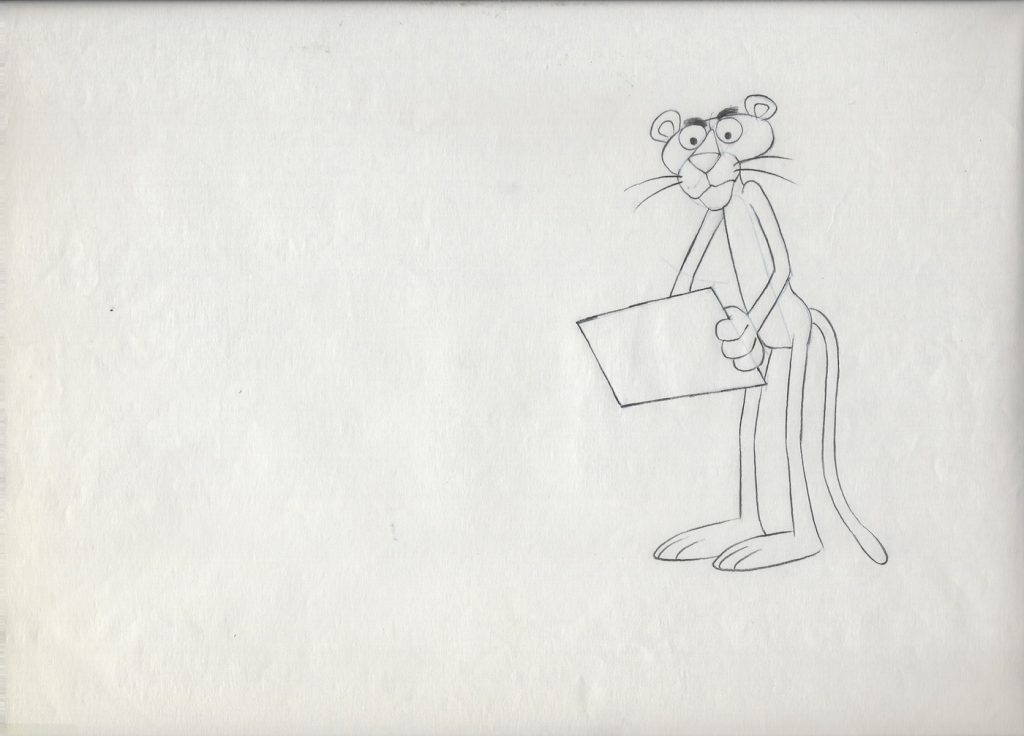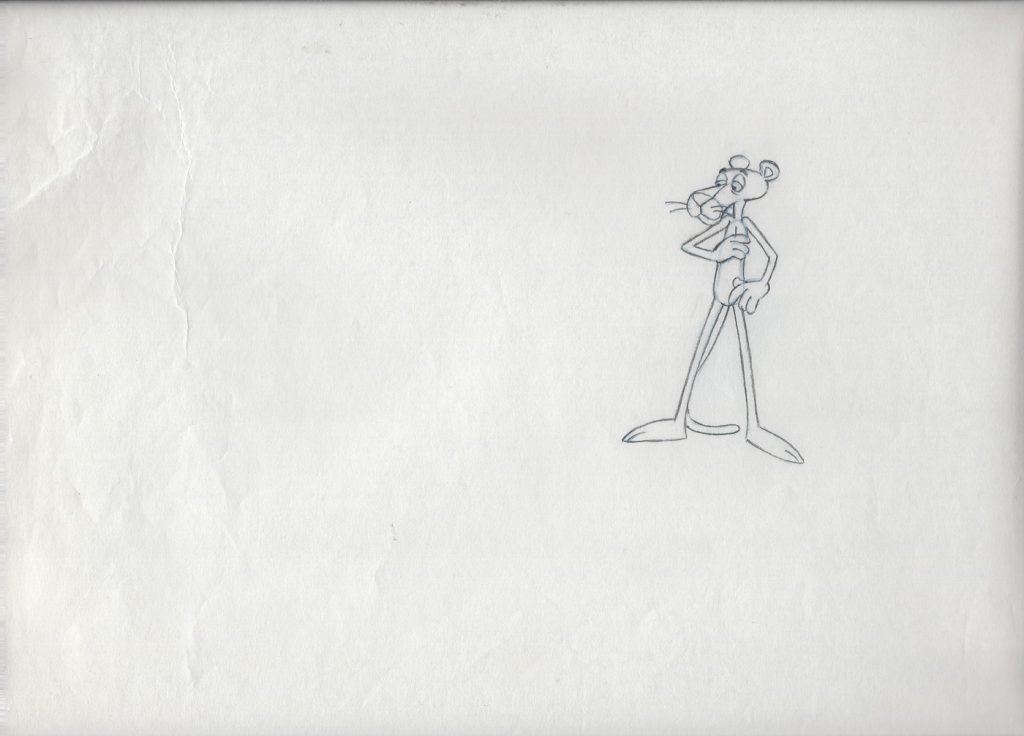For those who love Pink Panther, and for those who just love a good origin story, do I have an animation yarn for you! Perfect to file under “the incredibly true life of a longtime animation art gallery owner”, I’m going to share how I wound up with a box of original production cels and drawings of the storied and beloved character. Then, of course, I’ll talk about the magic of Friz Freleng, from his 4-time Oscar-winning work at Warner Bros, to his popular Pink Panther shorts through DePatie-Freleng Studios, to the freaky DePatie-Freleng connection to the 60s tv show I Dream of Jeannie, and 1977’s Star Wars: A New Hope.
When I got out of college in 1988, I was desperate to get away from the affectations of drama majors (I was in the fine arts program), and looked for a job in sales, something I’d done since I was 15. One of many jobs I applied to was as the gallery director for a gallery that had been around since 1979, but was switching to all animation. It would be one of the first 5 animation galleries in the world. (I knew of Gallery Lainzburg, Circle Galleries, and Seaside, but assume there was one more I didn’t know about!)
I got hired. At the time, my partner and hubby Michael Barry was running the frame shop in that space, and I knew I’d be longterm friends with him when I met him, but the owner was a total sexist creep. I figured I could handle him, which turned out to be the case, but he taught me that everyone should work ONE TIME for a total creep, so they know what to avoid in the future!
I set out to learn absolutely everything I could about animation and animation art. I wanted to know the history, the people who were important to the industry and cartoons I loved, and of course, where to find art to sell, since at this point it was absolutely not something the world saw as “real art”. So I started reading…thank GODDESS for Jerry Beck and Leonard Maltin’s book “Of Mice and Magic”, from 1987, and Jerry Beck’s “Looney Tunes and Merry Melodies” published in 1989, when there were so few books about animation, and the subsequent masterpiece by Frank Thomas and Ollie Johnston, “The Illusion of Life”, which is a must-have for animation fans.
I also started calling around, trying to track down some of these animators. You wouldn’t believe some of the artists I got to speak to, and even become friends with, before they passed away. This was early days in the shift to “animation superstar” folks like Eric Goldberg and Andreas Deja, and much as some folks knew who Chuck Jones was, he wasn’t the household name he has become since then. People like Friz Freleng, Jay Ward, Frank Thomas and Ollie Johnston, and John Hench were not well-known at all outside the industry, so once I tracked them down, they were happy to talk to me.
I traveled a lot to the west coast back then, and went to visit and talk to these animators a lot. At the time, Jay Ward and some of the animators who had worked on his shows had a trailer on Sunset Boulevard across from the Chateau Marmont called The Dudley Do-Right Emporium, where they’d sell scene cels and merchandise featuring Rocky and Bullwinkle, and I think he might have already had cancer, but I got to talk to him a lot before he passed away in late 1989.
Here’s a great little PBS doc Of Moose and Men: The Rocky and Bullwinkle Story:
Around that time, I also started talking to Friz Freleng. The first time I called him on the phone, he was a bit wary, but we did get to talking about WB cartoons, since my dad and I had watched all the ones he’d worked on and loved them, so I knew them really well. Four of his cartoons from his era at Warner Bros won Oscars, Tweety Pie (1947), Speedy Gonzales (1955), Birds Anonymous (1957) and Knighty Knight Bugs (1958), and he was the only animator who created a Bugs cartoon that won an Oscar, which is nuts. Chuck Jones’s What’s Opera Doc? didn’t even get nominated! He also won an Oscar as producer and director under his own name for his first Pink Panther short, 1964’s The Pink Phink. I knew all of this, and knew the cartoons, so that was what got us talking, plus he was an accomplished musician and music fan, so we had that to chat about…in the process, I learned so much about animation history, and about his part in it. This was also the first time I recognized that animation directors tended to downplay their importance to art history.
Anyway, before one of the times we met in 1989, I asked if he had any art he’d be willing to sell. He brought out a big box of cels and drawings. (I think he had a lot of them). I asked if I could buy it, and we made a deal. There were some cels and lots of drawings, all, he said, from The Pink Panther Show. I can’t confirm that, but I do know I bought them from him in 1989. I’m sure I should have asked him for art from the early days of Pink Panther, or from Warner Brothers cartoons, and maybe I did. I don’t remember. I just remember being beside myself that the artist and director himself would sell me art from what was one of my favorites growing up, and something my dad and I watched all the time.
Through the years, I’ve sold the art here and there, though haven’t ever put it on the website. The cels are far gone, (though of course my dad has a production cel and drawing, hand-chosen way back then) but there are still a few drawings available from this treasure trove. So now I’m putting them on the website. I hope some of you who are fans like me buy them, because they aren’t expensive, and have a great story!



You can see them all as I add them, HERE.
*Bear in mind, there are shadows of stickers on the lower corner of most of the backs of these drawings (originally written by Friz or someone in his employ, I’m not sure which!)
There are drawings from a variety of cartoons, including Pink Elephant (1975), Pink Pro (1976), Sprinkle Me Pink (1978) and the Olympinks (1980). Thanks for my friend and fellow animation enthusiast and expert Todd Federman for ID’ing the drawings and finding the moments they appear in each film. What a wonderful collab!
Here’s one cartoon represented in the collection, The Pink Pro. We have a drawing that’s a held pose from the short!
Here’s the cartoon featurette released in conjunction with the 1980 olympics (the one with the “mirawhere our hockey team won!)
—
Now, about Friz himself, his career, and his work at DePatie Freleng:
Friz started animating in high school, and applied to a newspaper contest in Kansas City, Missouri and and won, and Hugh Harman won 2nd or 3rd prize. He answered an ad for an office boy at United Film Ad Service, where Walt Disney had started, and Harman was already working. When Walt Disney left UFAS and moved to California, he took a bunch of guys with him from that company, including Ub Iwerks, Hugh Harman, and Rudolf Ising. In 1927, Freleng joined them. He went on to work for Harman and Ising, who were creating a studio. After working with them for a while, he continued on to Warner Bros, when Schlesinger was at the helm, moving up the ranks to the top quickly. There, he created Porky Pig, directing the character’s premiere in 1935’s I Haven’t Got a Hat. He also created Yosemite Sam in 1945.
Freleng directed three shorts based on Robert Louis Stevenson’s 1886 novella Strange Case of Dr. Jekyll and Mr. Hyde, including Dr. Jerkyl’s Hide (1954), the Bugs short, Hyde and Hare (1955), and Hyde and Go Tweet, my favorite Tweety and Sylvester short, in 1960.
Here’s a little clip from that wonderful cartoon:
As you can see, Freleng was a master of comic timing, and as talented in that aspect of his craft as Chuck Jones, but with a different style. Freleng, in fact, hired Chuck in the late 1930s.
When Warner closed in 1963, Freleng created a new company with his former boss at WB, producer David H. DePatie. Their most enduring and successful cartoon property was Pink Panther. Right at the beginning of their partnership, DePatie-Freleng was commissioned to create the opening credits to The Pink Panther feature film in 1963. Freleng created Pink in partnership with layout artist and director Hawley Pratt.
I love how clearly you can see that the character is hand-inked. That pink outline fairly jumps off the screen!
Henry Mancini, who wrote the theme song, was nominated for an Academy Award for his score. Through the success of those opening credits, the film’s distributor United Artists commissioned Freleng to create a short cartoon featuring the character. The Pink Phink, in 1964, went on to win an Oscar for best animated short. Ultimately, that led to an NBC anthology series called The Pink Panther Show in 1969, which ran for 11 years.
While DePatie-Freleng was in business, they also created the opening title sequence for I Dream of Jeannie, and contributed special effects to A New Hope in 1977. If you’ve ever wondered how those lightsabers emit their blue or red “blades”, now you know!
Here’s the iconic opening sequence of I Dream of Jeannie. I was shocked to see cels from this sequence recently went for over $20,000 at auction!
It’s not like you need to see this again (and..spoiler alert if you haven’t seen the movie!) here are the animated lightsabers in action:
Friz passed away at 89 in 1995. I’m so glad I got to ask him so many questions when I had the chance!
We’re adding Pink Panther drawings we have from my time with Friz as quickly as possible, and you can see them all HERE, or contact us to see if we have any others that we might not have put on the site yet. Most are $95 or even less, so they’re going fast!
Here’s a great little doc about Pink Panther:
and if you want to see Friz talk about his career, here’s an interview with the man himself:


This has to be one of my favorite blog posts! I leaned so much about this genius animator and this has brought back great memories of the cartoons I used to watch growing up! Thank you for including the opening sequence to ” I Dream Of Jeannie” too! Fantastic post!